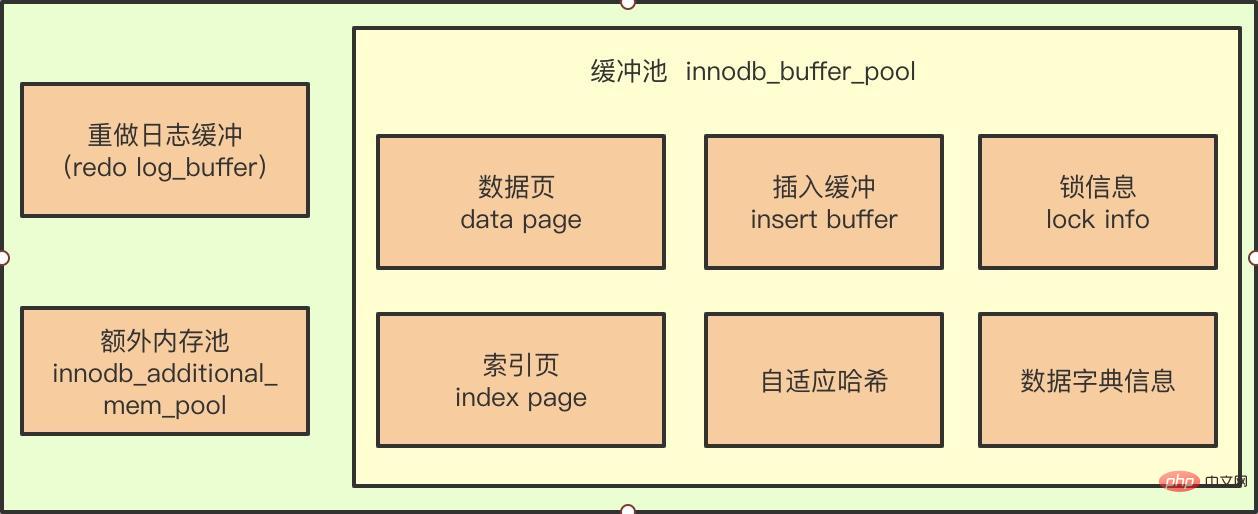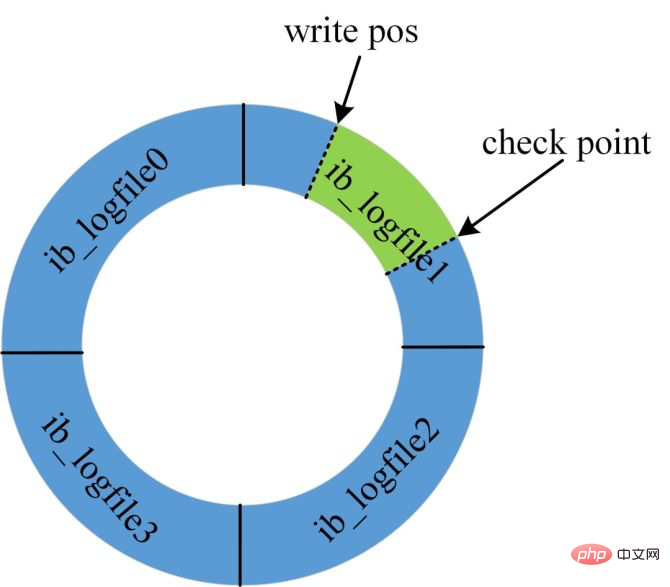Understand InnoDB's Checkpoint technology
mysql教程栏目带大家了解InnoDB的Checkpoint技术。

一句话概括,Checkpoint技术就是将缓存池中脏页在某个时间点刷回到磁盘的操作
遇到的问题 ?

都知道缓冲池的出现就是为了解决CPU与磁盘速度之间的鸿沟,免得我们在读写数据库时还需要进行磁盘IO操作。有了缓冲池后,所有的页操作首先都是在缓冲池内完成的。
如一个DML语句,进行数据update或delete 操作时,此时改变了缓冲池页中的记录,此时因为缓冲池页的数据比磁盘的新,此时的页就叫做脏页。
不管怎样,总会后的内存页数据需要刷回到磁盘里,这里就涉及几个问题:
- 若每次一个页发生变化,就将新页的版本刷新到磁盘,那么这个开销是非常大的
- 若热点数据集中在某几个页中,那么数据库的性能将变得非常差
- 如果在从缓冲池将页的新版本刷新到磁盘时发生了宕机,那么数据就不能恢复了
Write Ahead Log(预写式日志)
WAL策略解决了刷新页数据到磁盘时发生宕机而导致数据丢失的问题,它是关系数据库系统中用于提供原子性和持久性(ACID 属性中的两个)的一系列技术。
WAL策略核心点就是
redo log,每当有事务提交时,先写入 redo log(重做日志),在修改缓冲池数据页,这样当发生掉电之类的情况时系统可以在重启后继续操作
WAL策略机制原理
InnoDB为了保证数据不丢失,维护了redo log。在缓冲池的数据页修改之前,需要先将修改的内容记录到redo log中,并保证redo log早于对应的数据页落盘,这就是WAL策略。
When a failure occurs and memory data is lost, InnoDB will restore the buffer pool data pages to the state before the crash by replaying the redo log when restarting.
Checkpoint
It stands to reason that with the WAL strategy, we can sit back and relax. But the problem appears again in the redo log:
- The redo log cannot be infinite, and we cannot endlessly store our data waiting to be refreshed to the disk
- In When the database is idle and restored, if the redo log is too large, the cost of recovery will also be very high
So in order to solve the refresh performance of dirty pages, at what time and under what circumstances should dirty pages be refreshed? The refresh uses Checkpoint technology.
Purpose of Checkpoint
1. Shorten the recovery time of the database
When the database is idle and restored, there is no need to redo all log information. Because the data page before Checkpoint has been flushed back to the disk. Just restore the redo log after the Checkpoint.
2. When the buffer pool is not enough, flush the dirty pages to the disk.
When the buffer pool space is insufficient, the least recently used page will overflow according to the LRU algorithm. If This page is a dirty page, so you need to force a Checkpoint to flush the dirty page, that is, the new version of the page, back to the disk.
3. When the redo log is unavailable, refresh the dirty pages

As shown in the figure, the redo log is unavailable because the current database The designs are all recycled, so the space is not infinite.
When the redo log is full, because the system cannot accept updates at this time, all update statements will be blocked.
At this time, a Checkpoint must be forced to be generated. The write pos needs to be pushed forward, and the dirty pages within the pushing range need to be flushed to the disk.
Type of Checkpoint
The time when the Checkpoint occurs , conditions and selection of dirty pages are very complex.
Checkpoint How many dirty pages are flushed to disk each time?
Where does Checkpoint get dirty pages from every time?
When is Checkpoint triggered?
Faced with the above problems, the InnoDB storage engine provides us with two Checkpoints internally:
-
Sharp Checkpoint
When the database is shut down, all dirty pages are flushed back to the disk. This is the default working method. The parameter innodb_fast_shutdown=1
-
Fuzzy Checkpoint
Inside the InnoDB storage engine Using this mode, only a part of the dirty pages are flushed, instead of flushing all dirty pages back to disk
What happens with FuzzyCheckpoint
-
Master Thread Checkpoint
Flushes a certain proportion of pages back to disk from the dirty page list in the buffer pool almost every second or every ten seconds.
This process is asynchronous, that is, the InnoDB storage engine can perform other operations at this time, and the user query thread will not be blocked
-
FLUSH_LRU_LIST Checkpoint
Because the LRU list must ensure that a certain number of free pages can be used, if there are not enough, pages will be removed from the tail. If the removed pages have dirty pages, this Checkpoint will be performed.
After version 5.6, this Checkpoint is placed in a separate Page Cleaner thread, and users can control the number of available pages in the LRU list through the parameter innodb_lru_scan_depth. The default value is 1024
-
Async/Sync Flush Checkpoint
refers to the situation where the redo log file is unavailable. At this time, some pages need to be forcibly flushed back to the disk, and the dirty pages are removed from the dirty page list. The selected
5.6 version will not block user queries
-
Dirty Page too much Checkpoint That is, the number of dirty pages is too large, causing the InnoDB storage engine to force a Checkpoint.
The purpose is generally to ensure that there are enough available pages in the buffer pool.
It can be controlled by the parameter innodb_max_dirty_pages_pct. For example, the value is 75, which means that when the dirty pages in the buffer pool occupy 75%, CheckPoint is forced to be performed
Summary
Because of the gap between CPU and disk, buffer pool data pages appear to speed up database DML operations
Because buffer pool data pages are consistent with disk data Sexual problems, resulting in WAL strategy (the core is redo log)
Because of the refresh performance problem of buffer pool dirty pages, Checkpoint technology appeared
InnoDB In order to improve execution efficiency, every DML operation does not interact with the disk for persistence. Instead, write the redo log first through Write Ahead Log to ensure the persistence of things.
For the buffer pool dirty pages modified in the transaction, the disk will be flushed asynchronously, and the availability of memory free pages and redo log is guaranteed through Checkpoint technology.
More related free learning recommendations: mysql tutorial(Video)
The above is the detailed content of Understand InnoDB's Checkpoint technology. For more information, please follow other related articles on the PHP Chinese website!

Hot AI Tools

Undresser.AI Undress
AI-powered app for creating realistic nude photos

AI Clothes Remover
Online AI tool for removing clothes from photos.

Undress AI Tool
Undress images for free

Clothoff.io
AI clothes remover

Video Face Swap
Swap faces in any video effortlessly with our completely free AI face swap tool!

Hot Article

Hot Tools

Notepad++7.3.1
Easy-to-use and free code editor

SublimeText3 Chinese version
Chinese version, very easy to use

Zend Studio 13.0.1
Powerful PHP integrated development environment

Dreamweaver CS6
Visual web development tools

SublimeText3 Mac version
God-level code editing software (SublimeText3)

Hot Topics
 1389
1389
 52
52
 what is mysql innodb
Apr 14, 2023 am 10:19 AM
what is mysql innodb
Apr 14, 2023 am 10:19 AM
InnoDB is one of the database engines of MySQL. It is now the default storage engine of MySQL and one of the standards for binary releases by MySQL AB. InnoDB adopts a dual-track authorization system, one is GPL authorization and the other is proprietary software authorization. InnoDB is the preferred engine for transactional databases and supports transaction security tables (ACID); InnoDB supports row-level locks, which can support concurrency to the greatest extent. Row-level locks are implemented by the storage engine layer.
 How MySQL sees InnoDB row format from binary content
Jun 03, 2023 am 09:55 AM
How MySQL sees InnoDB row format from binary content
Jun 03, 2023 am 09:55 AM
InnoDB is a storage engine that stores data in tables on disk, so our data will still exist even after shutdown and restart. The actual process of processing data occurs in memory, so the data in the disk needs to be loaded into the memory. If it is processing a write or modification request, the contents in the memory also need to be refreshed to the disk. And we know that the speed of reading and writing to disk is very slow, which is several orders of magnitude different from reading and writing in memory. So when we want to get certain records from the table, does the InnoDB storage engine need to read the records from the disk one by one? The method adopted by InnoDB is to divide the data into several pages, and use pages as the basic unit of interaction between disk and memory. The size of a page in InnoDB is generally 16
 How to handle mysql innodb exception
Apr 17, 2023 pm 09:01 PM
How to handle mysql innodb exception
Apr 17, 2023 pm 09:01 PM
1. Roll back and reinstall mysql. In order to avoid the trouble of importing this data from other places, first make a backup of the database file of the current library (/var/lib/mysql/location). Next, I uninstalled the Perconaserver 5.7 package, reinstalled the original 5.1.71 package, started the mysql service, and it prompted Unknown/unsupportedtabletype:innodb and could not start normally. 11050912:04:27InnoDB:Initializingbufferpool,size=384.0M11050912:04:27InnoDB:Complete
 MySQL storage engine selection comparison: InnoDB, MyISAM and Memory performance index evaluation
Jul 26, 2023 am 11:25 AM
MySQL storage engine selection comparison: InnoDB, MyISAM and Memory performance index evaluation
Jul 26, 2023 am 11:25 AM
MySQL storage engine selection comparison: InnoDB, MyISAM and Memory performance index evaluation Introduction: In the MySQL database, the choice of storage engine plays a vital role in system performance and data integrity. MySQL provides a variety of storage engines, the most commonly used engines include InnoDB, MyISAM and Memory. This article will evaluate the performance indicators of these three storage engines and compare them through code examples. 1. InnoDB engine InnoDB is My
 How to solve phantom reading in innoDB in Mysql
May 27, 2023 pm 03:34 PM
How to solve phantom reading in innoDB in Mysql
May 27, 2023 pm 03:34 PM
1. Mysql transaction isolation level These four isolation levels, when there are multiple transaction concurrency conflicts, some problems of dirty reading, non-repeatable reading, and phantom reading may occur, and innoDB solves them in the repeatable read isolation level mode. A problem of phantom reading, 2. What is phantom reading? Phantom reading means that in the same transaction, the results obtained when querying the same range twice before and after are inconsistent as shown in the figure. In the first transaction, we execute a range query. At this time, there is only one piece of data that meets the conditions. In the second transaction, it inserts a row of data and submits it. When the first transaction queries again, the result obtained is one more than the result of the first query. Data, note that the first and second queries of the first transaction are both in the same
 Explain InnoDB Full-Text Search capabilities.
Apr 02, 2025 pm 06:09 PM
Explain InnoDB Full-Text Search capabilities.
Apr 02, 2025 pm 06:09 PM
InnoDB's full-text search capabilities are very powerful, which can significantly improve database query efficiency and ability to process large amounts of text data. 1) InnoDB implements full-text search through inverted indexing, supporting basic and advanced search queries. 2) Use MATCH and AGAINST keywords to search, support Boolean mode and phrase search. 3) Optimization methods include using word segmentation technology, periodic rebuilding of indexes and adjusting cache size to improve performance and accuracy.
 How to use MyISAM and InnoDB storage engines to optimize MySQL performance
May 11, 2023 pm 06:51 PM
How to use MyISAM and InnoDB storage engines to optimize MySQL performance
May 11, 2023 pm 06:51 PM
MySQL is a widely used database management system, and different storage engines have different impacts on database performance. MyISAM and InnoDB are the two most commonly used storage engines in MySQL. They have different characteristics and improper use may affect the performance of the database. This article will introduce how to use these two storage engines to optimize MySQL performance. 1. MyISAM storage engine MyISAM is the most commonly used storage engine for MySQL. Its advantages are fast speed and small storage space. MyISA
 Tips and Strategies to Improve MySQL Storage Engine Read Performance: Comparative Analysis of MyISAM and InnoDB
Jul 26, 2023 am 10:01 AM
Tips and Strategies to Improve MySQL Storage Engine Read Performance: Comparative Analysis of MyISAM and InnoDB
Jul 26, 2023 am 10:01 AM
Tips and strategies to improve the read performance of MySQL storage engine: Comparative analysis of MyISAM and InnoDB Introduction: MySQL is one of the most commonly used open source relational database management systems, mainly used to store and manage large amounts of structured data. In applications, the read performance of the database is often very important, because read operations are the main type of operations in most applications. This article will focus on how to improve the read performance of the MySQL storage engine, focusing on a comparative analysis of MyISAM and InnoDB, two commonly used storage engines.




